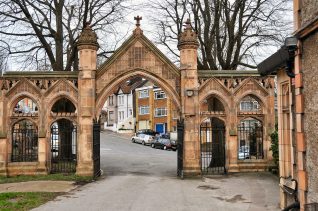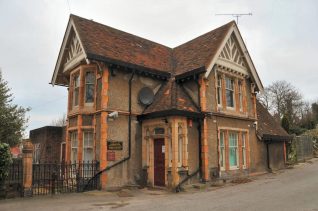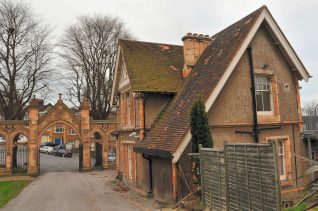The Entrance Gates
The entrance gate to Brighton and Preston Cemetery forms part of a screen of five bays of buff terracotta, flint, and wrought iron; it is late Gothic in style and dated 1885. The central bay is broad and high, forming the carriage arch. The carriage arch consists of panelled and pinnacled piers, the arch between having pointed-arched intrados and gabled extrados. The tympanum is filled with quatrefoil ornament superimposed with the words ‘BRIGHTON & PRESTON CEMETERY’. Each of the two narrower bays on either side reproduces the extrados/intrados arrangement, but with a Tudor-arched opening below it. The inner bay on either side forms a pedestrian entrance; the outer bay is filled with a wrought-iron screen.

Entrance gates (external view) to Brighton and Preston Cemetery

Entrance gates(interior view) to Brighton and Preston Cemetery

The Lodge: Brighton and Preston Cemetery

The Lodge: Brighton and Preston Cemetery
The Entrance Lodge
The entrance lodge is also dated 1885 on the chimneystack. The building has two storeys over a basement. It is designed in the Old English style, with gabled wings of one-window range facing south and east; there is another gabled wing under a cat slide roof running north. The porch is in the angle between the two. It is single storey with a hipped roof and Tudor-arched door case of terracotta; it has a fanlight and sidelights. The wing facing south has a canted bay to two storeys, the windows of which are flat-arched to the ground floor but with cusped mouldings to the first storey. The wing facing east has tripartite windows to the ground and first floor; there is timberwork to the face of the gable and moulded barge-boards.




Comments about this page
I and, (I think), both my older brothers used to deliver newspapers to the lodge. During the early 70’s the lodge was occupied by the Scott family who subesquently owned the newsagents a little further down Hartington Road on the corner with Brading Road. As a child, living almost opposite the stonemasons just below the cemetery, I well remember watching funerals coming up Hartington Road and pausing while the undertakers called at the lodge – presumably for paperwork. It was also interesting to me to see which funerals warranted lots of cars and which poor souls had few friends or relatives to mark their passing.
Seeing the photo of the Lodge brought back memories when a few years ago I visited this cemetery with my son since a number of our family are buried here. My paternal Grandfather George Lade was buried here in January 1939. Although his wife Kate married twice more and spent her final years in Australia dying in May 1978 I called into the Lodge to check what records they had about my Grandfather’s burial plot. To my delight the staff showed my son and I an old ledger with handwritten ink entries which not only gave the grave number and date when my Grandmother’s ashes were added to her husband’s grave but also the dates when the headstone’s inscriptions were added and even the depth of the grave was recorded.
The Scott family did indeed live at the cemetery lodge from 1957 until 1995. My father was the superintendent and Managing Director of the cemetery and Downs Crematorium throughout that time. My parents bought the newsagents at the bottom of Brading Road in order to afford their own house when my father retired from his job.
Add a comment about this page